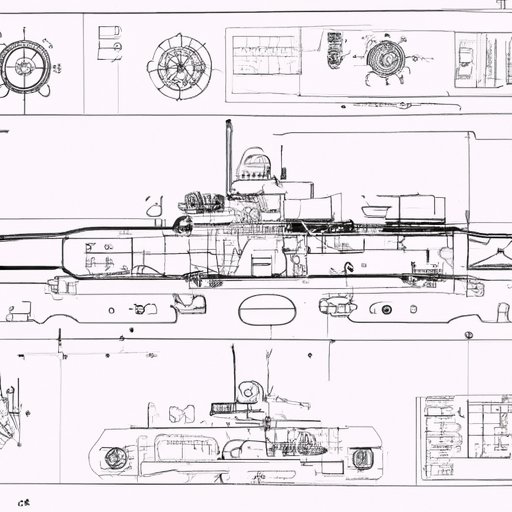Introduction
A submarine is a type of underwater vehicle that is used for a variety of purposes, ranging from military operations to scientific exploration. This article will explore how a submarine works, examining the different components, propulsion methods, and types of submarines. Additionally, it will look at the history of submarines and their current role in the world.

Exploring the Fundamentals of Submarine Technology
In order to understand how a submarine works, it is important to have an overview of the components that make up a submarine. These components include the hull, control surfaces, ballast tanks, propulsion systems, and other systems such as navigation and communication. The hull is the outer shell of the submarine, which provides protection from the outside environment. The control surfaces are located on the exterior of the hull, and they allow the submarine to maneuver in the water. The ballast tanks contain air or water, which can be used to adjust the submarine’s buoyancy in the water.
The propulsion system is what allows the submarine to move through the water. There are several different types of propulsion systems, including nuclear power, diesel-electric, and air-independent propulsion. Nuclear power is the most powerful and efficient method of propulsion, but it is also the most expensive. Diesel-electric propulsion uses a diesel engine to generate electricity, which is then used to power electric motors. Air-independent propulsion is a newer technology that uses a fuel cell to generate electricity without needing to draw oxygen from the atmosphere.
A Step-by-Step Guide to How Submarines Function
Once the various components of a submarine are understood, it is possible to begin exploring how submarines actually function. In order to move through the water, submarines rely on two main components: propulsion and control surfaces. The propulsion system generates thrust, which pushes the submarine forward. The control surfaces, such as rudders and hydroplanes, help to steer the submarine.
The submarine’s buoyancy is adjusted by using ballast tanks. When these tanks are filled with air, the submarine rises to the surface. When they are filled with water, the submarine sinks. By adjusting the amount of air or water in the tanks, the submarine can change its depth in the water.

Examining the Different Types of Submarines
There are three main types of submarines that are currently in use: nuclear-powered, diesel-electric, and air-independent propulsion. Nuclear-powered submarines are the most powerful and advanced type of submarine. They are powered by a nuclear reactor, which produces energy that is used to generate electricity. This electricity powers the submarine’s propulsion system and other systems.
Diesel-electric submarines are less powerful than nuclear-powered submarines, but they are much cheaper to build and operate. They use a diesel engine to generate electricity, which is then used to power electric motors. This type of propulsion is quieter than nuclear power, making it well-suited for covert operations.
Air-independent propulsion submarines are the newest type of submarine. They use a fuel cell to generate electricity without needing to draw oxygen from the atmosphere. This makes them quieter and more efficient than other types of submarines.

An Overview of the Components of a Submarine
In addition to the propulsion and control systems, submarines also contain a variety of other components. The power source is typically either a nuclear reactor or a diesel engine, depending on the type of submarine. Navigation and communication systems are used to keep track of the submarine’s position and communicate with other vessels. Weapons systems are also commonly found on submarines, although their exact nature depends on the purpose of the submarine.
Investigating the History of Submarines
The first submarines were developed in the 1600s, but they were not very effective. It wasn’t until the late 19th century that submarines began to be used in warfare. During World War I and II, submarines played an important role in naval battles. Submarines were used to sink enemy ships, as well as to protect friendly vessels from attack.
Analyzing the Role of Submarines in Today’s World
Submarines still play an important role in both military and scientific applications. In the military, submarines are used for reconnaissance, surveillance, and offensive operations. Submarines are also used in scientific exploration, as they can access parts of the ocean that would otherwise be inaccessible. For example, submarines have been used to investigate deep-sea ecosystems and uncover new species.
Conclusion
This article has explored the fundamentals of submarine technology, from an overview of its components to the different types of submarines. It has also investigated the history and current role of submarines in both military and scientific applications. Submarines are complex pieces of technology, but understanding how they work can provide insights into their importance in today’s world.
(Note: Is this article not meeting your expectations? Do you have knowledge or insights to share? Unlock new opportunities and expand your reach by joining our authors team. Click Registration to join us and share your expertise with our readers.)
